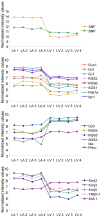Transcriptional analysis of the mammalian heart with special reference to its endocrine function
- PMID: 19486520
- PMCID: PMC2694839
- DOI: 10.1186/1471-2164-10-254
Transcriptional analysis of the mammalian heart with special reference to its endocrine function
Abstract
Background: Pharmacological and gene ablation studies have demonstrated the crucial role of the endocrine function of the heart as mediated by the polypeptide hormones ANF and BNP in the maintenance of cardiovascular homeostasis. The importance of these studies lies on the fact that hypertension and chronic congestive heart failure are clinical entities that may be regarded as states of relative deficiency of ANF and BNP. These hormones are produced by the atrial muscle cells (cardiocytes), which display a dual secretory/muscle phenotype. In contrast, ventricular cardiocytes display mainly a muscle phenotype. Comparatively little information is available regarding the genetic background for this important phenotypic difference with particular reference to the endocrine function of the heart. We postulated that comparison of gene expression profiles between atrial and ventricular muscles would help identify gene transcripts that underlie the phenotypic differences associated with the endocrine function of the heart.
Results: Comparison of gene expression profiles in the rat heart revealed a total of 1415 differentially expressed genes between the atria and ventricles based on a 1.8 fold cut-off. The identification of numerous chamber specific transcripts, such as ANF for the atria and Irx4 for the ventricles among several others, support the soundness of the GeneChip data and demonstrates that the differences in gene expression profiles observed between the atrial and ventricular tissues were not spurious in nature. Pathway analysis revealed unique expression profiles in the atria for G protein signaling that included Galphao1, Ggamma2 and Ggamma3, AGS1, RGS2, and RGS6 and the related K+ channels GIRK1 and GIRK4. Transcripts involved in vesicle trafficking, hormone secretion as well as mechanosensors (e.g. the potassium channel TREK-1) were identified in relationship to the synthesis, storage and secretion of hormones.
Conclusion: The data developed in this investigation describes for the first time data on gene expression particularly centred on the secretory function of the heart. This provides for a rational approach in the investigation of determinants of the endocrine of the heart in health and disease.
Figures





Similar articles
-
The physiological and pathophysiological modulation of the endocrine function of the heart.Can J Physiol Pharmacol. 2001 Aug;79(8):705-14. Can J Physiol Pharmacol. 2001. PMID: 11558679 Review.
-
Atrial natriuretic factor and brain natriuretic peptide gene expression in the spontaneous hypertensive rat during postnatal development.Am J Hypertens. 1998 Aug;11(8 Pt 1):1006-18. doi: 10.1016/s0895-7061(98)00116-2. Am J Hypertens. 1998. PMID: 9715795
-
Ras dexamethasone-induced protein 1 is a modulator of hormone secretion in the volume overloaded heart.Am J Physiol Heart Circ Physiol. 2012 May 1;302(9):H1826-37. doi: 10.1152/ajpheart.01085.2011. Epub 2012 Mar 9. Am J Physiol Heart Circ Physiol. 2012. PMID: 22408026
-
Selective changes in natriuretic peptide and early response gene expression in isolated rat atria following stimulation by stretch or endothelin-1.Cardiovasc Res. 1994 Oct;28(10):1519-25. doi: 10.1093/cvr/28.10.1519. Cardiovasc Res. 1994. PMID: 8001040
-
Mechanical and neuroendocrine regulation of the endocrine heart.Cardiovasc Res. 1996 Jan;31(1):7-18. Cardiovasc Res. 1996. PMID: 8849584 Review.
Cited by
-
Potential functions of esophageal cancer-related gene-4 in the cardiovascular system.Front Med. 2019 Dec;13(6):639-645. doi: 10.1007/s11684-019-0701-0. Epub 2019 Aug 29. Front Med. 2019. PMID: 31468282 Review.
-
Functional dynamics of G protein-coupled receptors reveal new routes for drug discovery.Nat Rev Drug Discov. 2025 Apr;24(4):251-275. doi: 10.1038/s41573-024-01083-3. Epub 2025 Jan 2. Nat Rev Drug Discov. 2025. PMID: 39747671 Review.
-
Atrial identity is determined by a COUP-TFII regulatory network.Dev Cell. 2013 May 28;25(4):417-26. doi: 10.1016/j.devcel.2013.04.017. Dev Cell. 2013. PMID: 23725765 Free PMC article.
-
Cardiac natriuretic peptides.Nat Rev Cardiol. 2020 Nov;17(11):698-717. doi: 10.1038/s41569-020-0381-0. Epub 2020 May 22. Nat Rev Cardiol. 2020. PMID: 32444692 Review.
-
Transcriptional enhancers in protein-coding exons of vertebrate developmental genes.PLoS One. 2012;7(5):e35202. doi: 10.1371/journal.pone.0035202. Epub 2012 May 2. PLoS One. 2012. PMID: 22567096 Free PMC article.
References
Publication types
MeSH terms
Substances
Associated data
- Actions
LinkOut - more resources
Full Text Sources
Molecular Biology Databases
Research Materials
Miscellaneous

